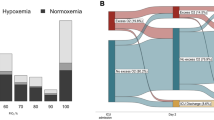Abstract
Objective
To evaluate fluconazole pharmacokinetics and the dosage best suited to maintain effective plasma concentration in patients with continuous hemodiafiltration.
Design and setting
Prospective study in the general intensive care unit of a university hospital.
Patients
Four critically ill patients being treated with fluconazole and receiving continuous hemodiafiltration.
Interventions
Fluconazole was administered at three dosing regimens: 200 and 400 mg every 24 h, 400 mg every 12 h, and 800 mg every 24 h.
Measurements and results
The following pharmacokinetic variables for fluconazole were obtained: The mean volume distribution of steady state dosed at 400 mg every 12 h and 800 mg every 24 h were 0.55±0.23 and 0.71±0.16 l/kg, half-life of the elimination phase 8.08±0.83 and 9.12±0.75 h, total body clearance of fluconazole 1.14±0.44 and 0.98±0.20 ml/kg per minute, respectively. None of the dosing regimens reached the effective plasma trough concentration of fluconazole; however, simulation study found the recommended dose.
Conclusions
Continuous hemodiafiltration is highly effective in removing fluconazole from circulation. We recommend fluconazole to be dosed at 500–600 mg intravenously every 12 h in patients receiving hemodiafiltration. This dosing regimen resulted in adequate trough plasma levels for systemic fungal infection.



Similar content being viewed by others
References
Rex JH, Bennett JE, Sugar AM, Pappas PG, Horst CM, Edwards JE, Washburn RG, Scheld WM, Karchmer AW, Dine AP, Levenstein MJ, Webb CD (1994) A randomized trial comparing fluconazole with amphotericin B for the treatment of candidemia in patients without neutropenia. N Engl J Med 331:1325–1330
Berl T, Wilner KD, Gardner M, Hansen RA, Farmer B, Baris BA, Henrich WL (1995) Pharmacokinetics of fluconazole in renal failure. J Am Soc Nephrol 6:242–247
Debruyne D, Ryckelynck JP, Moulin M, Hurault de Ligny B, Levaltier B, Bigot MC (1990) Pharmacokinetics of fluconazole in patients undergoing continuous ambulatory peritoneal dialysis. Clin Pharmacokinet 8:491–498
Kishino S, Koshinami Y, Hosoi T, Suda N, Takekuma Y, Gandoh S, Furukawa H, Todo S, Miyazaki K (2001) Effective fluconazole therapy for liver transplant recipients during continuous hemodiafiltration. Ther Drug Monit 23:4–8
Muhl E, Martens T, Iven H, Rob P, Bruch HP (2000) Influence of continuous veno-venous haemodiafiltration and continuous veno-venous haemofiltration on the pharmacokinetics of fluconazole. Eur J Clin Pharmacol 56:671–678
Debruyne D (1997) Clinical pharmacokinetics of fluconazole in superficial and systemic mycoses. Clin Pharmacokinet 33:52–77
Grant SM, Clissold SP (1990) Fluconazole: a review of its pharmacodynamic and pharmacokinetic properties, and therapeutic potential in superficial and systemic mycoses. Drugs 39:877–916
Cociglio M, Brandissou S, Alric R, Bressolle F (1996) High-performance liquid chromatographic determination of fluconazole in plasma. J Chromatogr B Biomed Appl 686:11–17
Yamaoka K, Tanigawara Y, Nakagawa T, Uno T (1981) A pharmacokinetic analysis program (multi) for microcomputer. J Pharm Dyn 4:879–885
Klepser ME, Wolfe EJ, Jones RN, Nightingale CH, Pfaller MA (1997) Antifungal pharmacodynamic characteristics of fluconazole and amphotericin B tested against Candida albicans. Antimicrob Agents Chemother 41:1392–1395
Fischman AJ, Alpert NM, Livnu E, Ray S, Sinclair I, Callahan RJ, Correia JA, Webb D, Strauss HW, Rubin RH (1993) Pharmacokinetics of 18F-labeled fluconazole in healthy human subjects by positron emission tomography. Antimicrob Agents Chemother 37:1270–1277
Shrikhande S, Friess H, Issenegger C, Martignoni ME, Yong H, Gloor B, Yeates R, Kleeff J, Büchler MW (2000) Fluconazole penetration into the pancreas. Antimicrob Agents Chemother 44:2569–2571
Hughes CE, Bennett RL, Tuna IC, Beggs WH (1988) Activities of fluconazole (UK 49:858) and ketoconazole against ketoconazole-susceptible and -resistant Candida albicans. Antimicrob Agents Chemother 32:209–212
Debruyne D, Ryckelynck JP (1993) Clinical pharmacokinetics of fluconazole. Clin Pharmacokinet 24:10–27
Author information
Authors and Affiliations
Corresponding author
Rights and permissions
About this article
Cite this article
Yagasaki, K., Gando, S., Matsuda, N. et al. Pharmacokinetics and the most suitable dosing regimen of fluconazole in critically ill patients receiving continuous hemodiafiltration. Intensive Care Med 29, 1844–1848 (2003). https://doi.org/10.1007/s00134-003-1980-z
Received:
Accepted:
Published:
Issue Date:
DOI: https://doi.org/10.1007/s00134-003-1980-z




